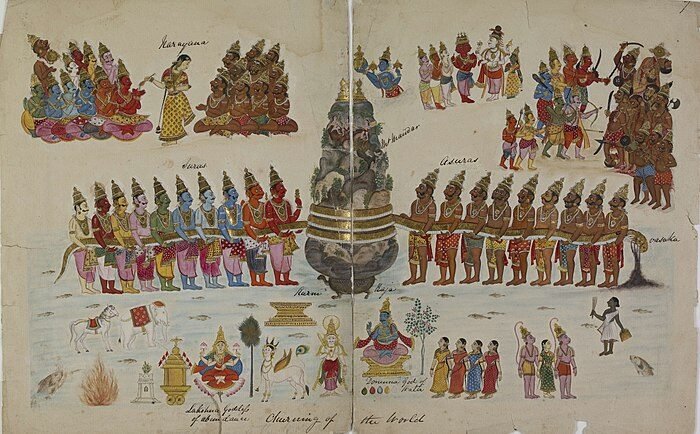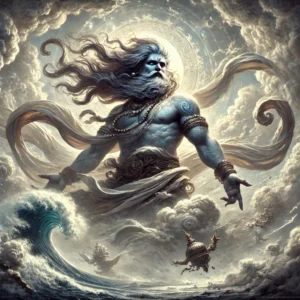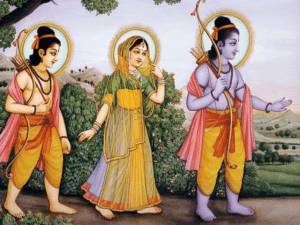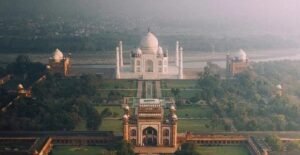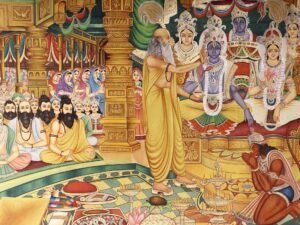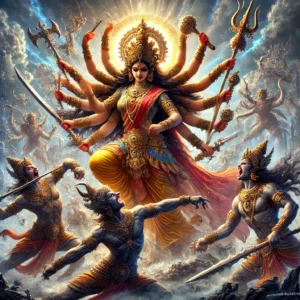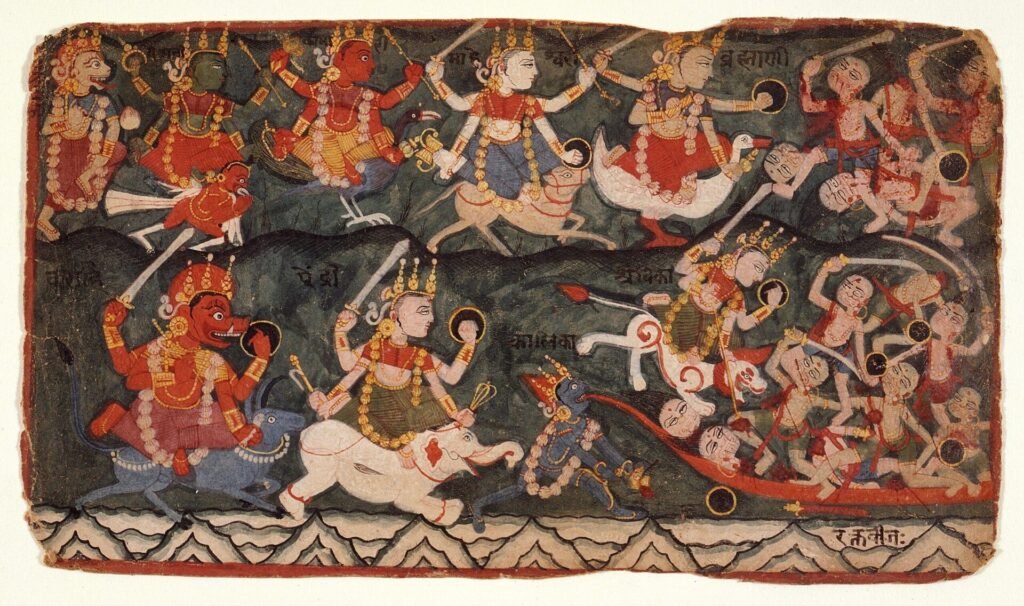
The Puranas, a significant body of ancient Indian literature, form one of the cornerstones of Hindu religious and cultural traditions. Written primarily in Sanskrit, these texts serve as both religious scriptures and historical chronicles, preserving stories of gods, goddesses, sages, kings, and the universe’s creation, dissolution, and recreation cycles.
The Puranas are known for their mythological narratives, theological teachings, genealogies, cosmological theories, and instructions on dharma (righteousness).
This article will delve into the structure, classification, themes, and significance of the Puranas in Indian culture, exploring how these ancient texts continue to impact Hindu spirituality and philosophy.
Etymology and Definition
The term Purāṇa (पुराण) in Sanskrit means “ancient” or “old,” deriving from the root “purā,” which means “before” or “of ancient times.” Puranas are referred to as smriti literature, meaning that they are “remembered” rather than “heard” (shruti), the latter category being primarily reserved for the Vedas.
Puranas are often described as a genre of texts that narrate history in a way that transcends time. Unlike historical texts that focus strictly on fact-based events, the Puranas often blend mythology, folklore, religious beliefs, and philosophical teachings, making them essential in preserving the essence of Hindu cosmology and religious practice.
Structure of the Puranas
Though the Puranas span diverse topics and stories, they share a common structure. Traditionally, a Purana should consist of five characteristics, known as Panchalakshana (five distinguishing traits):
- Sarga (Creation): The process of the universe’s creation.
- Pratisarga (Secondary Creation): The cycles of destruction and re-creation.
- Vamsha (Genealogies of Gods and Sages): The lineages of gods, sages, and kings.
- Manvantara (Cosmic Cycles): The reign of the Manus, mythic rulers who govern various cycles of time (Manvantaras).
- Vamshanucharita (Historical Accounts): Stories of royal dynasties and their deeds.
Not all Puranas strictly adhere to this structure, but these elements are generally prevalent.
Classification of the Puranas
The Puranas are traditionally classified into three major categories based on their focus on different aspects of divinity:
- Sattva Puranas (Vaishnava Puranas): These focus primarily on Lord Vishnu and his incarnations. Some prominent Vaishnava Puranas include:
- Vishnu Purana
- Bhagavata Purana
- Narada Purana
- Garuda Purana
- Rajas Puranas (Brahma Puranas): These Puranas center around Lord Brahma, the creator deity. Some notable examples are:
- Brahma Purana
- Brahmanda Purana
- Brahmavaivarta Purana
- Tamas Puranas (Shaiva Puranas): These Puranas predominantly glorify Lord Shiva. Major examples include:
- Shiva Purana
- Linga Purana
- Skanda Purana
Each of these divisions reflects the different sects within Hinduism, with Vaishnavism, Shaivism, and Shaktism (worship of the Goddess) being the principal traditions.
Major Puranas
There are 18 Mahapuranas (Great Puranas) and 18 Upapuranas (Minor Puranas). The Mahapuranas are considered more authoritative and comprehensive, while the Upapuranas provide supplementary material. Some of the most important Puranas include:
- Bhagavata Purana: One of the most revered texts in Hinduism, especially in the Vaishnava tradition, it narrates the stories of Vishnu, particularly the life and exploits of his incarnation Krishna.
- Vishnu Purana: A comprehensive text that covers the five major characteristics of the Puranas, it elaborates on the mythology, history, and cosmology associated with Vishnu.
- Shiva Purana: A key text for Shaivites, it details the various aspects of Shiva, his family, and his devotees, presenting philosophical discussions on the nature of divinity.
- Markandeya Purana: Famous for the Devi Mahatmya, a text that glorifies the Goddess Durga, this Purana is especially important for the Shakta tradition (worshippers of the Goddess).
- Garuda Purana: A Vaishnava text, it is often associated with funerary rites and the afterlife, including descriptions of heaven, hell, and the soul’s journey after death.
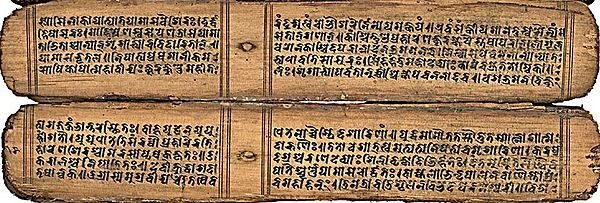
Themes and Content
The Puranas cover a vast range of subjects, reflecting Hindu cosmology, theology, mythology, and philosophy. Here are some key themes found across the texts:
- Cosmogony and Cosmology:
- The Puranas describe the creation and dissolution of the universe in recurring cycles known as Yugas (ages).
- The concepts of the cosmic ocean, the role of deities in creation, and the vision of time as cyclical are deeply embedded in these stories.
- Genealogy of Gods and Sages:
- The Puranas provide detailed genealogies of gods, demigods, kings, sages, and other mythological characters.
- These lineages serve both as religious history and moral instruction.
- Avatars of Vishnu:
- Many Puranas, particularly the Bhagavata and Vishnu Puranas, extol the ten avatars (incarnations) of Vishnu, including Rama, Krishna, and others.
- These stories emphasize the concept of divine intervention to restore order in the universe.
- Dharma and Ethical Teachings:
- Puranas often serve as guides to living a righteous life, offering instructions on dharma (duty), artha (wealth), kama (pleasure), and moksha (liberation).
- They explore the importance of virtues such as truth, compassion, and devotion.
- Pilgrimages and Holy Places:
- The Puranas detail sacred geography, explaining the significance of holy sites and temples, including instructions for religious pilgrimages.
Cultural and Religious Significance
The Puranas have had a profound influence on Hindu religious practices, art, and culture. They serve as an accessible medium for conveying complex metaphysical ideas, making them a popular source of religious education across the centuries.
- Temple Traditions: Many temple rituals and festivals are based on Purana stories. For instance, the celebration of Krishna’s birth during Janmashtami derives from the Bhagavata Purana.
- Art and Literature: Puranic themes have been a rich source of inspiration for Indian art, sculpture, painting, dance, and drama. The portrayal of mythological events and deities is central to Indian aesthetics.

- Devotional Practices: The Puranas, especially the Bhagavata Purana, emphasize bhakti (devotion) as a path to spiritual liberation. These texts encourage the development of a personal relationship with the divine.
- Ethical Guidelines: Beyond their mythological content, the Puranas provide practical advice on ethics, governance, and social conduct, offering a framework for personal and societal well-being.
The Puranas are an invaluable treasure trove of ancient Indian wisdom, encompassing the realms of mythology, theology, philosophy, history, and cosmology. Their stories, teachings, and philosophies offer insight into the eternal questions of existence, the nature of divinity, and humanity’s place in the cosmos.

